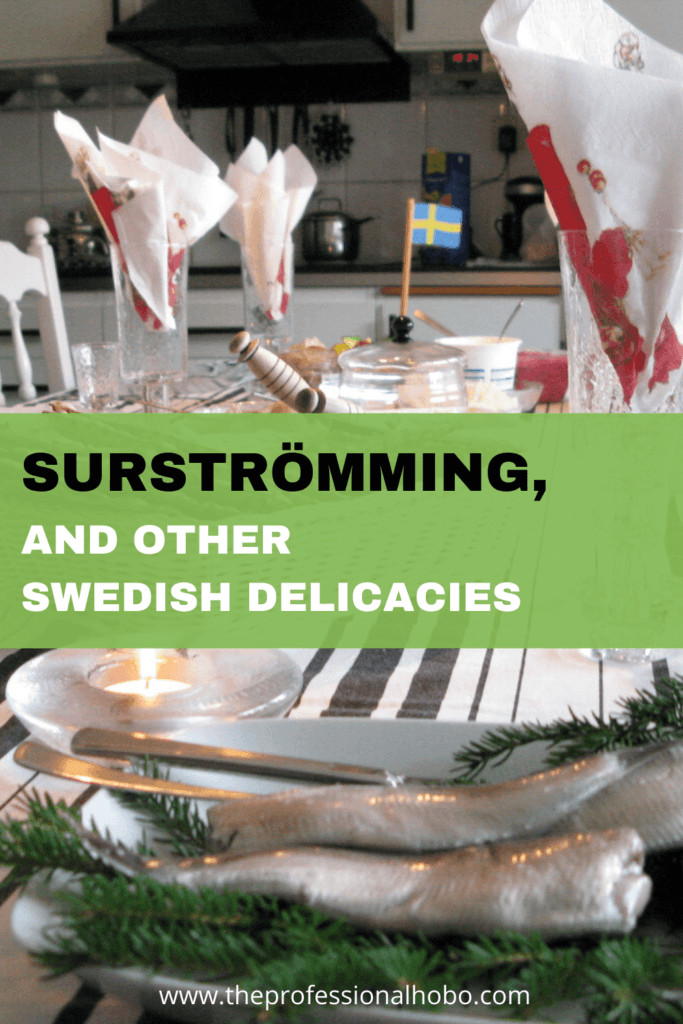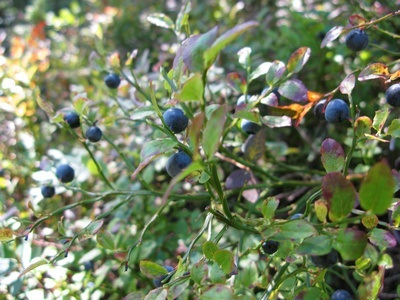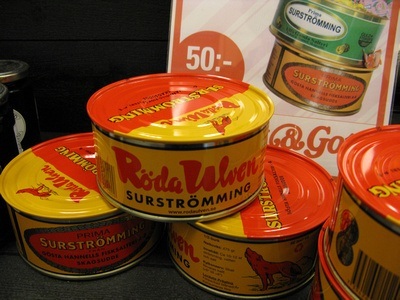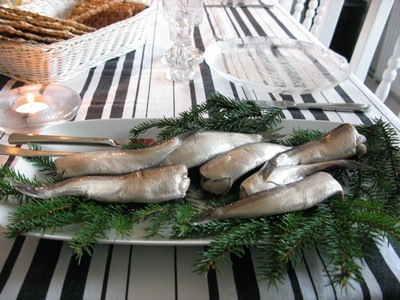“Time for a blueberry break!” announced my Swedish Squeeze whilst hiking through beautiful Skuleskogan National Park. Surrounded by dark green forests riddled with ancient granite outcroppings playing artfully with multiple bodies of water, this part of northern Sweden reminds me very much of northern Ontario in Canada. Except there are a few delicacies in Sweden that I’ve never had anywhere else (and sadly, may never find anywhere else either)…not the least of which is Surströmming.

This post was originally published in 2011. It has since been updated for accuracy of links and content.
But not all of these Swedish delicacies are what people would refer to as “enjoyable”.
Let’s start with the unanimously agreeable delicacies and work from there, shall we?
Berries in Sweden


Berries of all sorts are rampant in northern Sweden. Lingonberries (little red circular berries) make great preserves to go with meat or yoghurt, and Cloudberries (resembling yellow raspberries) are rightly referred to as “gold of the forest”.
Berry picking verges on a national sport here. Empty cars regularly line the highways, its occupants on a berry-picking mission. At dinner the other night, it was announced that some friends of my hosts had just picked 40 litres of lingonberries (all for personal consumption no less). It doesn’t matter who owns the property either; you can pick berries/fruit off any property as long as you’re not within sight-lines of the home.
Blueberries grow wild in many places around the world, but not as prolifically as I found in northern Sweden. They’re everywhere – and they’re delicious! I could have been stranded in the forest and happily survived for quite some time on blueberries alone.

So with increasingly blue hands and tongues, we helped ourselves to an appetizer of blueberries on the trail before finding the perfect spot for a picnic lunch, where we enjoyed some more Swedish delicacies:

Kaviar
“Ick! You told her about what?!” was the response of a friend we had dinner with in Stockholm when my Swedish Squeeze relayed his fondness for kaviar to me. “That stuff is full of junk! Ah well; give it a try I guess,” she said as she put some on the table with some Tunnbröd. I thought it curious that despite her reaction, she had it in her fridge nonetheless.
As it sounds, kaviar is a derivative of caviar – fish roe. But this popular incantation is doctored up with a bunch of preservatives and sugar and made available as a sort of paste in a tube. Despite the sugar content, kaviar is extremely salty, and at first I didn’t like it. But when the palate is properly prepared for it, and it’s served correctly (my favourite being with a hard-boiled egg), I learned to quite enjoy it.
Messmör

“Now if you want to try something nice, try Messmör,” said the same Stockholm friend. And out of the fridge came this margarine-like substance, also meant to be spread on Tunnbröd (but not with kaviar). This mildly sweet spread reminiscent of caramel with hints of vanilla was immediately enjoyable. Despite its sweetness, it can be served at any time of day (along with Tunnbröd, which appeared at almost every meal I ate in Sweden). It is liberally spread on breads and enjoyed much the way you’d enjoy butter or margarine.
Messmör is basically whey (the liquid leftover when you make cheese), boiled and boiled and boiled down to a paste, then sweetened with a hint of vanilla. Although it tastes a little too good to be healthy, apparently it’s relatively guilt-free.

When we moved from Stockholm to Örnsköldsvik – the town with three ski jumps in the middle – in northern Sweden, the household didn’t have any Messmör. Knowing that barring a return trip to Sweden this was likely my only chance to enjoy it, I humbly bought some at a grocery store and presented it at dinner one night. Everybody laughed, and I became playfully known for my love of Messmör, but I’ll note that I wasn’t the only person to enjoying it at most meals for the rest of the week!

Tunnbröd
Tunnbröd literally means “thin bread”, and these thin hard flatbreads can be (and in my experience were) served with every meal. Eat it plain with margarine, or add some cheese, sliced meat, tomatoes, or Messmör. Eat it open-faced, or snap it in half to enjoy it sandwich-style. Anything goes.
Although I’m not much of a bread fan (and can count the number of times I had wheat-based products during an entire summer in Canada on one hand), I found Tunnbröd quite addictive.
Surströmming

All of the above Swedish delicacies are well-accepted parts of Swedish culture and ingredients found in most Swedish kitchens. Surströmming, by contrast, is a love-it-or-hate-it sort of food, and I would wager that a good percentage of people who love it do so because it’s so easy to hate.
Literally meaning “sour strömming (herring)”, it’s fermented herring (fish). (Fermented ultimately being a euphemism for rotten, I think).
(And yes, I even tried some. More on that shortly).
In the video below, I tell the story of how Surströmming quite accidentally came to pass in the 1800s, at the hands of a bunch of Swedish sailors.
You’ll find cans of the stuff in the grocery store (alongside other types of herring, mostly pickled – which is delicious), and some cans are literally bulging at the seams. This is because the fermentation process continues beyond the canning, and in fact many airlines ban Surströmming because of the possibly explosive side effects at altitude.
And when you’re talking about rotten fish, explosions can be quite disastrous.
In fact, the Japanese released a study that cites the act of opening a can of Surströmming to unleash the worst smell of food in the world. This is a title I had formerly understood to be held by durian fruit, but after having the full Surströmming experience, I’d have to agree that it blows durian out of the water.

Despite this less-than-favourable introduction, Surströmming is nonetheless considered a Swedish delicacy, and if some people enjoy it, then I simply had to see what the appeal was. This experiment in trying something new turned into a family affair with my hosts pulling out all the stops to make this an experience for me.
Did I make it past opening the can? Could I manage to get past the smell to try it?
Watch this video to find out!



i didnt know berries were so important in sweden
You are so brave! I was getting chills watching you open the can. Even though you seemed to have a positive reaction, the line, “you can taste the smell a bit”, almost made me faint, lol. I wouldn’t be able to do it.
I love the pictures! 🙂
Sweden suits you, can’t wait to see more!
Nora, this video was adorable.
You were very brave, the first smell is unforgettable! Actually you’re lunch was very similar to mine, even the drinks 🙂 Skol!
@Henry – I don’t know if berries are important per se, but they certainly are rampant!
@Miki – I was told that Sweden really suited me because my (current) hair colour matches many of the reddish buildings! 🙂
@Megan – Thanks! It was fun.
@Célia – As we discussed earlier today in Lisbon, I think if you’re prepared for the worst, then it’s not so bad! 🙂
Awesome post… could totally relate to the berry stains- can’t help ourselves when it comes to fresh berries, yum.
But canned fish, no, don’t think so.
Thanks for sharing! 🙂
Nancy & Shawn
@Nancy & Shawn – Okay on the fish front, you can live vicariously through me. But I’m telling you – it was actually pretty good! 🙂
What an excellent video! And the effortlessly exotic way you pronounce “Surströmming” reminds me of how mind-expanding travel is.
Thanks for letting us all travel vicariously through you, while inspiring us to get out there ourselves.
@Jay – Wow, what a great compliment, thank you! Yes, I practiced my pronunciation of “Surströmming” quite a bit before recording this video! 🙂
I was surfing the web looking after different backpacking sites and then i found yours and that you had been in my home town! Berries are important here but its not just about the berries it’s also about being outdoor, picking the berries.
I hope that u tasted lingon berry jam, not only is it good with the meatballs at IKEA t, it’s delicious with other types of food to. But the must eat berry when visiting Sweden is hjortron, hot hjortron jam with ice cream is super delicious.
Also, they say that Swedish is one of the hardest languages to learn so i congratulate u on your pronunciation of Surströmming.
@Henrik – Indeed, picking berries is half the fun! And yes, I had fresh lingonberry jam with my cultur milk and muesli, which was very delicious. I’m not sure I tried hjortron, unless they’re also known as “cloudberries”…
That is raw fish in Surströmming? quite exotic ha?.. How does it taste?..
@Realtree – The fish is fermented. So yes, kind of raw. I think of it as a curing process gone awry! 🙂
I really would love to watch that video—unfortunately, we can’t get YouTube in China (or Facebook, or blogs from Blogspot, or CNN during rolling blackouts when they post something not so great about China). Good luck on the Great Train Challenge!
How can one taste a smell…one might ask… I just did watching your video….I am also surprised you know about Durian…king of the fruits as the Chinese call it and it tastes like rotten onions…got to be an acquired taste…Have you tried Japanases Natto…stinking beans they serve with rice for breakfast…you probably can write an essay about the world’s most stinking foods…enjoyed your post. Informative and very entertaining. Thanks
@Baron’s – As soon as I said “I can taste the smell a bit”, I wondered if people would understand! But there really was no other way to describe it at the time! 🙂
Yes, Durian – I couldn’t quite get into. People say if you get beyond the smell, the taste is to die for…I personally didn’t think it was worth it!
Now, the Durian’s cousin mr. Jackfruit – I can get into. The smell is much more mild, and it tastes like Juicy Fruit gum!
I finally got around to watching this visually great and satisfying video ….that rotten fish sounds like something I should try
@Baron’s – All in a day’s travel! 🙂
Hi Nora,
great to hear from you. The north of Sweden is still a paradise, I guess, I have never been north of Stockholm.
Your food descriptions are marvellous. Good fun to read and inspiring!
;-))
just saw the video…. hohohoh…. funny….. brave woman!
@Jutta – Northern Sweden was a real treat for me; I was there almost exactly one year ago! I also quite enjoyed Stockholm. Glad you enjoyed the video! 🙂
I thought you may enjoy this little piece I recently put together about Surströmming:
http://www.goodfoodrevolution.com/surstromming/
I have ordered a can and I am wondering if it is only eaten the traditional way or if there are recipes and also what would be an exceptable bread to substitute for tunnbrod if I can’t find any. I am a chef so a recipe for that would be ok as I don’t like to bake.
Hi Anthony,
Great question – but also a tough one! Surstromming is enough of an overpowering experience, that I don’t think there’s many things it could be prepared with, which might explain the lack of recipes to be found!
As for a replacement for tunbrod: I would say either matza crackers (or similar flatbread crackers), or pita bread, or even naan. (Tunnbrod comes in soft and hard; the more common being hard).
I would say the best way to enjoy it the first time is with some sort of flatbread, with boiled potatoes, sour cream, and sliced onions. From there, let your chef’s creativity be your guide!
Oh yes – and make sure you open the can outside. It will stink up your house for weeks if you open it inside!